Green Voter Energy
Air Date: Week of August 23, 2024
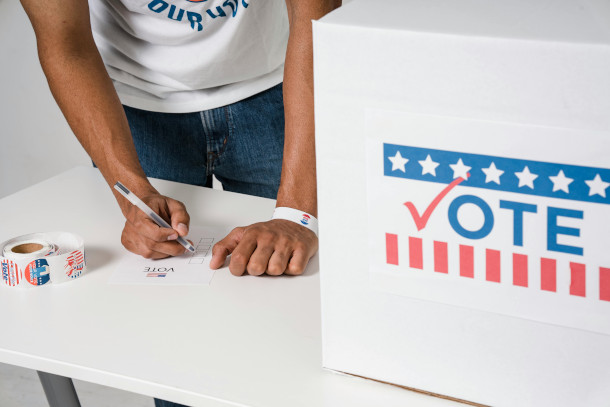
The 2024 elections are kicking into high gear, and youth voter turnout could make all the difference. (Photo: Sora Shimazaki, Pexels, CC)
A recent poll of 2,600 voters climate concerned young voters in five battleground states conducted by The Environmental Voter Project and Beacon Research found they favored Democratic Presidential candidate Kamala Harris. Nathaniel Stinnett the founder and executive of the Environmental Voter Project joined hosts Aynsley O’Neill and Steve Curwood to discuss the possible impact of Harris’ favorability amongst young green voters.
Transcript
O’NEILL: From PRX and the Jennifer and Ted Stanley Studios at the University of Massachusetts, Boston this is Living on Earth. I'm Aynsley O’Neill.
CURWOOD: And I’m Steve Curwood.
The race is off and running in this national election season, and green voters could make a huge difference. Joining us now is Nathaniel Stinnett from the Environmental Voter Project, for a look at some new data that’s come in. And wow, Nathaniel, what an interesting time to be talking about politics and polling, huh?
STINNETT: I know. I feel like 60 years worth of political news has happened just over the past six weeks, so I'm really excited for this conversation.
O'NEILL: So the Environmental Voter Project and Beacon Research, they just released poll findings indicating that Harris's nomination is quite popular among young voters in battleground states. How was that poll conducted, and did it specifically look at people who are likely to vote, or just young people in general?
STINNETT: So we polled over 2600 already registered voters, all of whom were young people. They were between the ages of 18 and 34, and they lived in battleground states. Now the way that we polled them was we used online panels, which is usually the best way to reach younger voters, and we polled at least 500 voters in each state so that we could get robust samples of both young likely voters and young unlikely voters in each of those states.
CURWOOD: So just how popular is Vice President Kamala Harris among young voters?
STINNETT: Kamala Harris literally has a higher favorability among young voters than Taylor Swift does, with Harris at 57% favorability and Swift at 51. Can you believe it? But they do different things well, so perhaps a more useful metric of Harris's popularity is not to compare her to Taylor Swift, but rather to look at what we call net favorability, which subtracts someone's unfavorable ratings from their favorable ratings, and this polling showed that Joe Biden is at negative 13 net favorability. Donald Trump is at negative nine, and Kamala Harris is at plus 16 net favorability. She's just trouncing Donald Trump and Joe Biden among younger voters.
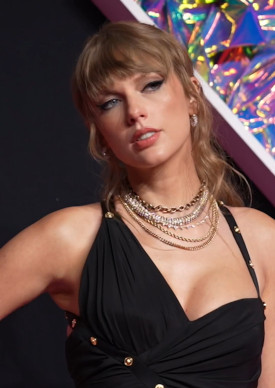
The Environmental Voter Project and Beacon Research teamed up to poll eligible young voters in battleground states. The poll found that Kamala Harris was more favorable than Taylor Swift. (Photo: iHeartRadioCA, Wikimedia Commons, CC BY 3.0)
O'NEILL: And so this was looking at battleground states. But what were those states? And to what extent can you tell whether or not this is reflected in other states as well?
STINNETT: So we ran this poll in five of the sort of seven battleground states that most people talk about: Arizona, Georgia, Nevada, North Carolina, and Pennsylvania. We did not include Michigan and Wisconsin. The reason we were just in those five states is those are the five states where the Environmental Voter Project works, and we were trying to do this as a public service, but also to inform our own voter turnout efforts. Now, as far as whether these numbers reflect what we might see among young voters in other states, well, to be honest, it's a little hard to tell. Part of the reason the Environmental Voter Project was conducting our poll was because there hadn't been much in depth polling of young voters on a state specific basis, but to the extent there is some polls out there, yes, we are seeing that Kamala Harris is doing consistently better with young voters than Joe Biden had been doing.
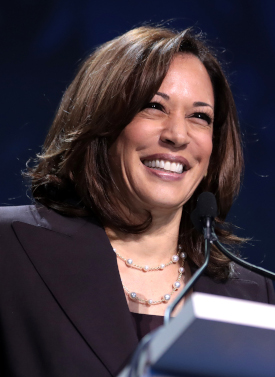
Polling indicates that Kamala Harris has a much higher favorability rating among young voters than current President Joe Biden. (Photo: Gage Skidmore, Wikimedia Commons, CC BY-SA 3.0)
CURWOOD: Now you've done some work in Florida in the past, not recently, not this particular round of polling. And we're wondering, to what extent might Florida be in play? I know that there's a referendum on reproductive rights there. Do you have any insights about polling data and or demographic data in places like Florida, maybe even Georgia, where you've identified environment centered voters? And I'm guessing, and this is a guess on my part, that environmentally focused voters would tend to fall more towards the looking for reproductive rights rather than restricting them.
STINNETT: That is a very, very good guess. Steve. You are absolutely right. Usually people who care deeply about preserving reproductive rights also care deeply about climate and environmental leadership. And you're also right that we do work in both Florida and Georgia, but we didn't poll particularly in Florida, but we do have some interesting insights, because when we polled in Arizona and Nevada, and just stay with me for a second. I know you weren't asking about those states, but they do offer some insights into Florida and Georgia. When we looked at Arizona and Nevada, we saw that both of those states have abortion rights ballot measures on their ballots this fall. And we saw in our polling in those two states that 31% of unlikely voters, so people who weren't intending to vote then reported that they were much more likely to vote after learning about these abortion ballot measures. And so I bring this up because it's a really useful data point for Florida, because Florida also has an abortion rights ballot measure on their ballot this fall, and we should certainly expect lots of young Floridians to come out and vote because of that. As for Georgia, they won't have a ballot measure this fall, but what we do know from this poll is that 25% of young Georgians say that protecting abortion rights is one of their top three priorities, and that might be enough to bring enough non voters off the sidelines in a really close state like Georgia, where abortion will be a campaign issue, even if it's not a ballot measure.

Nathaniel Stinnett is the executive director of the Environmental Voter Project, an organization that mobilizes potential voters whose main voting priority is the climate and environment. (Photo: Courtesy of Nathaniel Stinnett)
O'NEILL: I want to talk for a second about the point differential that we saw in that net favorability. So we have current President Joe Biden at negative 13, but his vice president now the Democratic nominee, Kamala Harris, plus 16. What is it about Harris that is more appealing to young voters in comparison to Biden?
STINNETT: Polls are better at figuring out what's happening than they are at figuring out why it's happening, but it does seem like it had grown impossible for President Biden to break out of the discussion about his age. There was nothing he could do or say to stop people from thinking about whether he was just too old to be president and so very simply, I think what's happening here is that Kamala Harris was able to launch a campaign and introduce herself to many people on her own terms, which Joe Biden was no longer able to do, and that's a huge advantage. And what young people are seeing so far is that she's a talented communicator for many of the values that Joe Biden tried to talk about, but nobody was listening because they kept on thinking about his age.
CURWOOD: Yeah. So Nathaniel, talk to us about what impact, if any, the pick for vice president that Kamala Harris made the coach, Tim Walz.
STINNETT: The coach!
CURWOOD: The coach! What impact did that have on young voters, doo you think?
STINNETT: Although it's hard to get precise data on this, one thing is really clear about Harris's pick of Walz as her running mate. Harris and Walz both come across as happy, genuine people, and because they both have those characteristics, they amplify each other, and they come to the foreground. And it's a real breath of fresh air to many young voters who had gotten pretty tired of slick, overproduced, often disingenuous politicians, and they really see Harris and Walz as just being real.
O'NEILL: Well, and a big issue for young voters is often turnout. You know, young people are not exactly known for high voter turnout. How important in this presidential election, 2024, how important is the youth vote going to be?
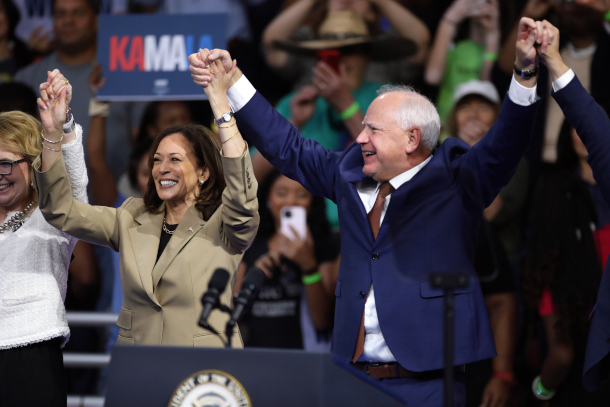
Nathaniel Stinnett believes that Harris’ and Walz’s happy, genuine personalities are refreshing to young voters. (Photo: Gage Skidmore, Flickr, CC BY-SA 2.0)
STINNETT: Well, I don't know how important it's going to be, but I sure know how important it could be. So young people are important, because 18 to 34, year olds make up almost a third of the country's eligible voters. But you're right to ask about turnout, because elections are decided by people who show up and vote, not by who's simply eligible to vote. And when we look at the data on turnout, this is what we see. In 2016 only 44% of 18 to 29 year olds voted, but then that shot up to 55% in 2020 so that was a big increase. But even then, it's nothing compared to the 72% turnout we see from people 65 and older. So the simple truth is that young voters could decide everything this fall, but it depends on whether they show up at 2016 levels, 2020 levels, or maybe even start voting as often as older voters do. There's a big range of outcomes and a lot of uncertainty, but there's no doubt that young voters could win or lose this election.
O’NEILL: We’re speaking with Nathaniel Stinnett of the Environmental Voter Project and we’ll be back in a moment to talk more about what states might be in play if environmentally concerned voters show up at the polls. Stay tuned to Living on Earth!
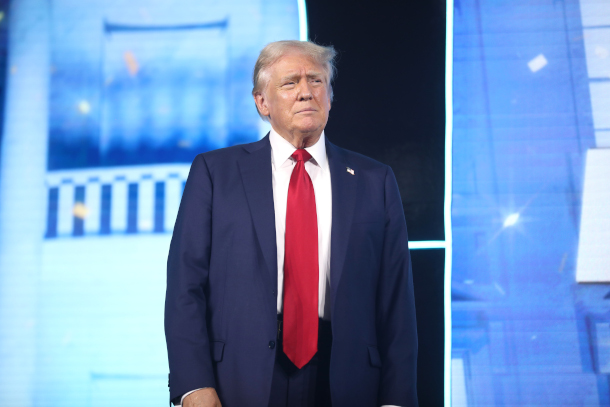
Though former President Donald Trump has a higher net favorability among young voters than President Joe Biden, his rating is 25 points lower than Vice President Kamala Harris. (Photo: Gage Skidmore, Flickr, CC BY-SA 2.0)
[MUSIC: Taylor Swift, “All To Well” (Taylor’s Version)” on Red (Taylor’s Version), Taylor Swift]
ANNOUNCER: Support for Living on Earth comes from Sailors for the Sea and Oceana. Helping boaters race clean, sail green and protect the seas they love. More information @sailorsforthesea.org.
[CUTAWAY MUSIC: Gene Ammons, “Someone to Watch over Me - Instrumental” on The Gene Ammons Story: Gentle Jug, Fantasy Inc.]
O’NEILL: It’s Living on Earth, I’m Aynsley O’Neill.
CURWOOD: And I’m Steve Curwood.
We’re back now with Nathaniel Stinnett from the Environmental Voter Project.
Nathaniel, in recent days, we've seen other pollsters, aside from yourself, see some shifts in previous dynamics. Joe Biden had the relatively narrow path to reelection, but now some of these pollsters are saying, well, you know, there are other states that might be in play. What do you think are the states to watch when it comes to the environmental vote in this election?

The Environmental Voter Project aims to mobilize unlikely environment-first voters, including young voters. They’ve found that door-to-door interactions and online ads are more effective at engaging young people than phone calls. (Photo: Courtesy of Nathaniel Stinnett)
STINNETT: There are four that really stick out, Arizona, Nevada, Georgia and Pennsylvania. So first, let me talk about the first three states, Arizona, Nevada and Georgia. These are all crucially important up and down the ballot, because they have a huge number of low propensity environmental voters, and if they show up, they could change everything. I mean, each of those states were decided by minuscule margins just four years ago. All right now, let me get to the fourth big enchilada state, Pennsylvania. In Pennsylvania, the Environmental Voter Project has identified 245,000 low propensity environmental voters, and Pennsylvania was decided by only 80,000 votes in 2020. And so simply put, it's going to be really hard for someone to win the White House this fall if they lose Pennsylvania, and those 245,000 potential brand new climate voters could easily make all the difference. So those are the four states that environmentalists should be watching on election night.
O'NEILL: And now, all right, we've talked about a couple of these key battleground states, but what are a couple of others that might be in play in addition to Arizona, Georgia, Nevada, Pennsylvania.
STINNETT: So it is clear that in addition to those states, three other places will be crucially important on election night, Wisconsin, Michigan and Nebraska's second congressional district. Now I think most people know how important Wisconsin and Michigan will be, but the Nebraska second is worth focusing on because it carries its own electoral college vote, and it's one of the closest districts in the country. Now, Biden won it by six points in 2020, but it's since been redrawn and is a few points more Republican leaning than before. I'm sorry to report to everybody that there are some nightmare scenarios where that one single electoral college vote in the Nebraska second could throw the whole country into a tied Electoral College, which, dear God, nobody wants. So watch the Omaha area on election night, because that one district's going to be really important.
O'NEILL: Environmental Voter Project's whole intent is mobilizing environment first voters, and I think with a particular interest in young voters. So what does that mobilization look like?
STINNETT: So the Environmental Voter Project is targeting 4.8 million climate first voters this fall, all of whom are already registered, but they're also unlikely to vote based on their previous voting history, and yes, many of them are young, close to 80% of them are under the age of 35. We'll be mobilizing them by phone calls, postcards, direct mail, door to door canvassing, and digital ads. And those last two methods, digital ads and door knocking are the most effective with younger voters, because they're not going to read their mail or answer a phone call from a number they don't recognize. So it's really important that we reach them online or face to face, and we're working with over 7,000 volunteers now to reach these very young, 4.8 million low propensity voters, and we're going nonstop through election day to get them to the polls.
CURWOOD: So at the end of the day, this is your business, environmental voters, and you have a project. But in the bigger scope of things, how important is it the work that you're doing and the electoral response of environmental voters?
STINNETT: No matter whom we elect, they are not going to lead on climate unless there is voter demand for them to lead on climate. You know, we spend so much time in election season thinking, "Oh, if only that person wins, then everything will be right," or "Oh my gosh, if that person wins, everything's going to be awful." And I don't want to claim that elections are unimportant. Obviously they are very important, and who wins is very important. But I think it's also important to know that just because the so called right candidate wins, they can't then just snap their fingers and get everything they want done, they still need to pick and choose what to spend their political capital on, and they ain't going to spend it on something that very few voters care about. So you ask about why the environmental voter projects work is so important. It's so important because we need to flood the electorate with climate voters. And until we do that, politicians aren't going to lead on climate not because they're bad people, but because the whole job of a politician is to win elections, and you do that not by appealing to what voters don't care about, but rather by appealing to what they do care about. So it has never been more important to get climate voters to the polls than it is this fall, and we're really, really excited about all the work that we're going to be doing over the next few months.
O'NEILL: We've been speaking with Nathaniel Stinnett, the founder and executive director of the Environmental Voter Project. Nathaniel, as always, thank you so much for joining us.
STINNETT: Thank you both for having me.
Links
Learn more about the Environmental Voter Project’s work.
Explore Harris’ presidential campaign.
Living on Earth wants to hear from you!
Living on Earth
62 Calef Highway, Suite 212
Lee, NH 03861
Telephone: 617-287-4121
E-mail: comments@loe.org
Newsletter [Click here]
Donate to Living on Earth!
Living on Earth is an independent media program and relies entirely on contributions from listeners and institutions supporting public service. Please donate now to preserve an independent environmental voice.
NewsletterLiving on Earth offers a weekly delivery of the show's rundown to your mailbox. Sign up for our newsletter today!
 Sailors For The Sea: Be the change you want to sea.
Sailors For The Sea: Be the change you want to sea.
 The Grantham Foundation for the Protection of the Environment: Committed to protecting and improving the health of the global environment.
The Grantham Foundation for the Protection of the Environment: Committed to protecting and improving the health of the global environment.
 Contribute to Living on Earth and receive, as our gift to you, an archival print of one of Mark Seth Lender's extraordinary wildlife photographs. Follow the link to see Mark's current collection of photographs.
Contribute to Living on Earth and receive, as our gift to you, an archival print of one of Mark Seth Lender's extraordinary wildlife photographs. Follow the link to see Mark's current collection of photographs.
 Buy a signed copy of Mark Seth Lender's book Smeagull the Seagull & support Living on Earth
Buy a signed copy of Mark Seth Lender's book Smeagull the Seagull & support Living on Earth

